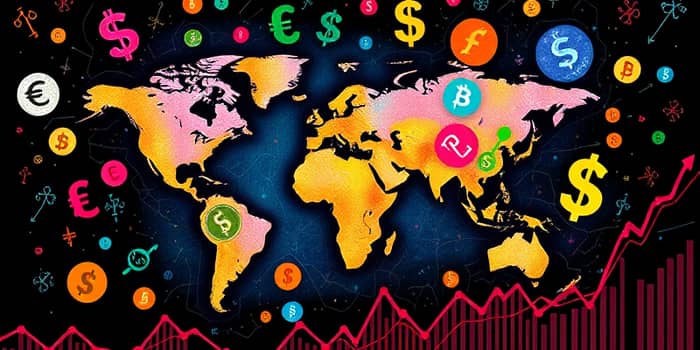
The foreign exchange market, often referred to as forex, stands as the world’s largest financial marketplace. Traders, institutions, and governments converge to buy, sell, and exchange national currencies, driving **unparalleled liquidity** and global economic activity. This article explores the market’s size, structure, trends, and practical strategies, equipping readers with the insight to navigate this dynamic arena.
By blending data, expert analysis, and real-world examples, we aim to inspire both seasoned professionals and aspiring traders. You will discover how major players operate, what fuels currency movements, and practical tactics to manage risk and seize opportunities.
In 2024, estimates place the forex market size between USD 792.43 billion and USD 861 billion, reflecting slight variations across sources. Projections forecast growth to USD 1,106.49 billion by 2029 and USD 1,535 billion by 2033. These figures imply a robust expansion driven by globalization, technological advances, and rising retail participation.
Average daily trading volume in over-the-counter forex instruments surpassed USD 1.165 trillion in April 2024, underscoring the market’s unmatched scale and velocity. Such extraordinary turnover enables continuous price discovery and provides ample opportunities for participants.
North America led the market with a 25.8% share in 2024, propelled by advanced trading platforms and deep institutional engagement. Key trading hubs span London, New York, Singapore, Hong Kong, and Tokyo, each fostering distinct regional liquidity peaks and market hours.
These entities leverage cutting-edge technology to deliver speed, reliability, and global connectivity, ensuring that market participants can transact around the clock.
The forex market operates as a global over-the-counter currency marketplace, meaning trades occur directly between parties, without a centralized exchange. Its principal functions include:
Participants range from central banks and multinational corporations to hedge funds, institutional investors, and individual traders. Each plays a role in providing liquidity, setting benchmarks, and shaping price trajectories through their collective actions.
Interest rate differentials remain a central catalyst for currency movements. When one economy’s rates rise relative to another’s, capital flows shift toward higher-yielding currencies, exerting upward pressure on their value. This dynamic invites strategic positioning around central bank announcements and macroeconomic data releases.
Rapid digitalization and globalization have democratized access to forex trading. Retail participants now account for a growing slice of volume, enabled by intuitive platforms, social trading networks, and educational content. Likewise, urbanization and smartphone proliferation support trading on-the-go, ensuring markets remain active 24 hours a day, five days per week.
Technological innovation, notably trading automation and analysis powered by AI and machine learning, accelerates decision-making and pattern recognition. From algorithmic strategies that exploit microsecond price discrepancies to sentiment analysis tools scouring global news feeds, technology shapes every facet of modern forex activity.
Late 2024 witnessed pronounced U.S. dollar strength, underpinned by resilient economic data, expectations of delayed Federal Reserve rate cuts, and political transitions. Against this backdrop, major pairs such as EUR/USD and USD/JPY experienced heightened volatility, offering fertile ground for short-term traders.
Emerging market currencies broadly weakened amid subdued Chinese growth and geopolitical uncertainties. This divergence highlighted the sensitivity of risk assets to global trade tensions and shifting policy stances.
Looking into 2025, potential drivers of volatility include:
Understanding currency pairs and lot sizes is fundamental. Major pairs like EUR/USD or USD/JPY trade large volumes and tight spreads, making them ideal for both novices and professionals. Trades are quoted in units called micro (1,000), mini (10,000), and standard (100,000) lots, offering scalable exposure.
Consider a hypothetical EUR/USD trade: if you buy one standard lot at 1.1000 and sell at 1.1050, you capture 50 pips, equating to USD 500 before costs. This straightforward example illustrates how small price moves can translate into significant profits—or losses—depending on leverage.
To thrive amidst uncertainty, adopt robust risk controls:
Moreover, integrate risk management and ESG integration by evaluating geopolitical risks and sustainable economic policies. For instance, currency valuations may benefit when a country demonstrates environmental stewardship and social stability, attracting long-term investment flows.
The foreign exchange market’s depth, round-the-clock operation, and sensitivity to global events make it both exhilarating and complex. By grounding your approach in data-driven analysis, disciplined risk management, and continuous education, you can navigate volatility and unlock opportunities.
Whether you aspire to trade major pairs or explore emerging market currencies, remember that forex success hinges on preparation and adaptability. Embrace technological tools, stay attuned to macroeconomic developments, and cultivate a mindset of lifelong learning. Your journey in the world’s largest financial market awaits—dive in with confidence and strategic foresight.
References













